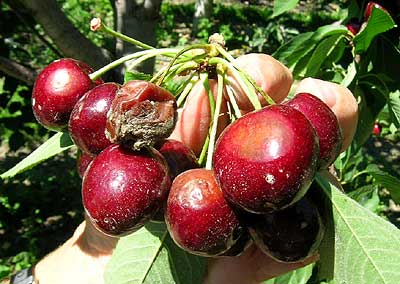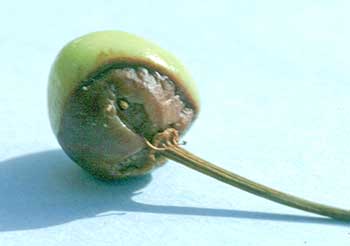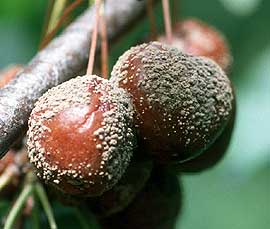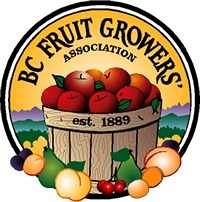Botrytis Rot of Cherry
General Description
Botrytis rot of cherry fruit is a common problem in the Okanagan and Creston valleys. Symptoms are similar to those caused by brown rot (Figs. 1-4). Fruit develop a brown decay and become covered with a growth of light brown or grey spores. Infested fruit become soft and watery. Correct diagnosis of the rot present is an important consideration when selecting fungicides.
 |
.jpg) |
| Figure 1. Botrytis rot of cherry. | Figure 2. Botrytis rot of cherry. |
 |
 |
| Figure 3. Botrytis rot of immature green cherry fruit. | Figure 4. Brown rot of cherry may look similar to botrytis rot |
Botrytis is favoured by wet weather during the blossom period. The fungus will grow on dead blossoms, aborted fruit and trapped leaf debris within the clusters, which then spreads to adjacent fruit. Similar to brown rot, immature fruit may become infected but not show visible symptoms until near harvest. The disease tends to be worse on varieties which develop tight clusters of fruit.
Management
Cultural Control
Prune to remove excessive branches for increased air flow, and shorten current season’s growth to reduce fruit cluster formation.
Chemical Control
Currently Fontelis (penthiopyrad) is the only fungicide registered for control of botrytis in stone fruit. Limit use to twice per season for resistance management.
Many fungicides used for brown rot, such as Cantus, Elevate 50WG, Fracture, Bravo ZN, Pristine WG, Kenja 400 SC, and Captan Supra or Maestro 80DF also have activity against botrytis. Optimal spray timing is not well understood, but should include protective coverage from full bloom through shuck fall, which are the highest risk stages for infection. Additional sprays may be needed to protect ripening fruit where disease pressure is high. On cherry varieties that cluster heavily, ensure good spray coverage into the clusters before they close up. Follow labels for rates and pre-harvest intervals. Where there is a range of rates on the label, the higher rate is more likely to be effective against botrytis. Note, do not use Bravo after shuck split or fruit injury may occur.
Resistance Management:
Botrytis is a fungus that develops resistance to fungicides very quickly and easily. For best management, rotate fungicides from different resistant groups and include some low-risk fungicides (captan, Fracture, Bravo) in your rotation.
Refer to the table: Chemical Classification & Pesticide Resistance Management for information on fungicide resistance groups and the risk of resistance for different products.
Updated July, 2018
